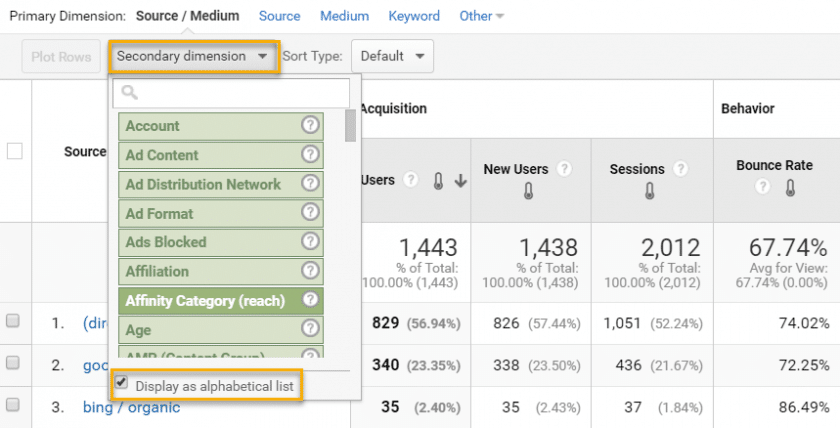Browsing the Midst of Additional Measurement in Google Analytics: A Comprehensive Exploration on Its Performance
In the realm of electronic analytics, the complexities of data interpretation frequently hold the trick to opening useful insights. Within the large toolkit of Google Analytics lies an attribute that offers as a covert gem for those that seek a much deeper understanding of individual behavior and internet site efficiency. Secondary dimensions, though seemingly uncomplicated at very first glance, harbor a wealth of untapped possible waiting to be utilized. As we start this trip to explore the nuanced functionality of secondary measurements, we will reveal just how this feature can illuminate patterns, reveal correlations, and inevitably pave the way for educated decision-making in the electronic landscape.
Understanding Second Measurements in Google Analytics

Recognizing how second measurements work is important for leveraging the full power of Google Analytics. By integrating primary metrics with additional measurements, you can gain useful understandings that drive informed decision-making and optimization strategies.
Leveraging Additional Measurements for Data Evaluation
Building upon the foundational understanding of just how secondary measurements boost information analysis in Google Analytics, the application of these extra layers of information becomes paramount in removing important insights for informed decision-making and optimization methods. By leveraging second measurements, experts can delve deeper right into the performance metrics by adding more context to the key dimensions, thus revealing covert patterns and relationships that may not appear in the beginning look. This deeper level of evaluation makes it possible for businesses to better understand customer actions, determine patterns, and identify locations for renovation.
Moreover, secondary measurements provide an even more comprehensive sight of the information, enabling division based upon various criteria such as demographics, devices, web traffic sources, and much more. This division helps with a more granular analysis, allowing services to tailor their projects and techniques to certain audience segments for boosted targeting and personalization. Basically, the tactical usage of second measurements empowers organizations to make data-driven choices that drive development and success in the digital landscape.
Advanced Methods for Second Dimension Application
Checking out complex methods to harness the complete possibility of secondary measurements in Google Analytics elevates the deepness and class of data analysis for tactical decision-making. One advanced technique for implementing additional measurements is using personalized dimensions. By defining customized dimensions, users can section information additionally to obtain more particular insights right into user habits, such as tracking interactions with particular components on a website or monitoring the efficiency of a certain marketing campaign. Another innovative strategy is the utilization of regex (routine expressions) within additional measurements. Regex permits even you can try these out more effective and versatile pattern matching, making it possible for individuals to produce complicated filters for data evaluation. Furthermore, incorporating additional dimensions with sophisticated segments can give also more granular understandings by using several layers of division to the data. This method permits a deeper understanding of customer behavior based upon different requirements at the same time. Carrying out these sophisticated methods for second measurements in Google Analytics empowers users to carry out a lot more innovative analysis and make data-driven decisions with accuracy.
Interpreting Insights Via Secondary Dimensions

When analyzing understandings through secondary dimensions, it is important to think about the context of the data and how different dimensions communicate with each various other. For example, understanding which specific web traffic sources bring about greater conversion rates or determining which tools customers like for making acquisitions can give workable understandings for maximizing advertising campaigns and improving total internet site performance. By very carefully checking out the data with second dimensions in mind, organizations can make educated choices that drive meaningful results and boost their digital presence.
Maximizing Efficiency With Second Measurements

One vital means to maximize performance with secondary measurements is by segmenting information a lot more granularly. This enables you to isolate particular elements that might be influencing your metrics and gain a far better understanding of what drives success or failure in your electronic efforts. As an example, by combining second measurements such as 'tool category' and 'touchdown page,' you can identify which gadget types are most effective for certain landing web pages, enabling you to customize your methods appropriately.
Additionally, using secondary measurements can assist you identify fads, patterns, and correlations that may not appear when assessing information with key measurements alone. This deeper level of evaluation can cause more informed decision-making and inevitably improve the total efficiency of your site or electronic advertising projects.
Final Thought
In verdict, secondary dimensions in Google Analytics play a critical duty in boosting information analysis and supplying deeper understandings right into web site efficiency. By making use of advanced strategies and interpreting the information properly, businesses can optimize their methods and improve overall efficiency. Understanding the functionality of second dimensions is crucial for making informed choices and driving success in the digital landscape.
By leveraging second measurements, analysts can dig much deeper into the performance metrics by including more context to the main measurements, therefore discovering surprise patterns and correlations that might not be noticeable at initial glance. One sophisticated strategy for carrying out second measurements is the use of custom-made measurements.Having actually understood advanced techniques like custom dimensions and regex for second measurement execution in Google Analytics, the following essential step is translating the important understandings obtained with these advanced data segmentation methods. Interpreting understandings with second measurements involves analyzing the connections between the key investigate this site and second measurements selected, uncovering patterns, fads, and correlations that may not be quickly noticeable when looking at the information in its entirety.When interpreting understandings via secondary measurements, it is important to think about the context of the data and exactly how various measurements communicate with each other.